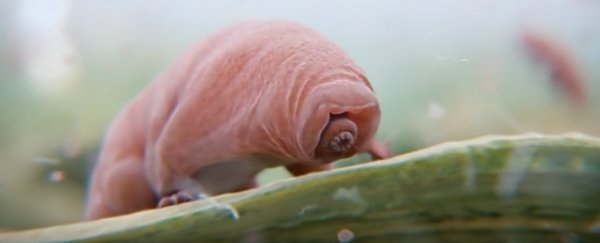Tiny tardigrades - also known as water bears and moss piglets - have many strange properties, including being able to withstand huge amounts of radiation, temperatures ranging from 150°C (302°F) to near absolute zero, and pressures six times greater than in the deepest ocean trenches.
They can have sex in space, be brought to life after being frozen solid for decades, and they look like this. Yep, tardigrades are impossibly weird and indestructible, and now scientists have figured out how to impart their unique ability to form living glass to other organisms.
If you're not familiar with this particular tardigrade superpower, for years, scientists have been trying to figure out how these microscopic creatures can survive years of extreme desiccation and near-100 percent water loss.
"They can remain like that in a dry state for years, even decades, and when you put them back in water, they revive within hours," Thomas Boothby from the University of North Carolina told The New York Times.
"They are running around again, they are eating, they are reproducing like nothing happened."
It was assumed that their survival relied on a sugar called trehalose, which is what brine shrimps - or sea monkeys - use to preserve their cells during desiccation.
But research has shown that trehalose levels are much lower in dried-out tardigrades than they are in brine shrimp, so that couldn't be the solution.
Turns out, what Boothby and his colleagues discovered in 2015 ended up being weirder than anyone had imagined - tardigrades produce a special type of 'bioglass' that holds their essential proteins and molecules in a suspended state until they're rehydrated back to life.
So water bears coat themselves in living glass when they're dried out, and plain old water will melt their proteins back to normal and snap them out of suspended animation.
Since identifying the proteins responsible for the production of this bioglass, called intrinsically disordered proteins (IDPs), Boothby and his team have figured out that they could engineer other creatures to carry these proteins and survive desiccation themselves.
As their name suggests, intrinsically disordered proteins are shapeless and highly flexible under normal conditions, but when extreme drying occurs, their production goes into hyperdrive, and they rearrange themselves into solid biological glasses.
These newly formed IDP glass structures target specific proteins, molecules, and other essential cell parts when the tardigrade starts losing water, and enclose them in stiff, protective envelopes so they don't fall apart during the desiccation process.
When the tardigrade is exposed to water, the glass melts and the IDPs return to their floppy, random state.
Weirdly enough, these proteins are essential for tardigrades to survive desiccation, but when Boothby and his team engineered water bears with low levels of IDPs, they did not affect their resilience against other stresses such as freezing.
When the team inserted these genes into living yeast and bacteria, they found that the TDPs protected them from extreme desiccation just like the tardigrades.
"TDPs are required to protect the tardigrades themselves from desiccation, but they also increase desiccation tolerance when put into bacteria and yeast," Boothby told George Dvorsky at Gizmodo.
"Amazingly, TDPs are sufficient even in a test tube to protect purified biological material like desiccation-sensitive enzymes. The glassy solids that they form are thought to coat desiccation sensitive molecules and physically prevent them from breaking apart, unfolding, or fusing."
While we've been hearing about this work for the past couple of years, we couldn't get too excited about the results because they had not been independently verified through peer-review.
The team's results have now officially been published, which means we have the proof-of-concept in hand to go and make this tardigrade superpower work for us.
And when I say "us", it's actually a possibility, because while yeast and bacteria aren't the most exciting organisms in the world, there are hints that TDPs could work in larger, more complex creatures too.
When the team decided to express the gene that controls IDP production in specially engineered human epithelial cells (HeLa), they found that it produced bioglass upon desiccation.
And a separate experiment last year also found that the protein that protects tardigrades from crazy amounts of radiation can be transferred to cultures of human cells, which really does send the mind boggling.
Other potential applications include developing crops that can survive severe, long-lasting droughts, or even medications that can finally be stored at room temperature instead of having to be constantly chilled - something that makes supply in remote and developing communities extremely difficult.
"Being able to stabilise sensitive pharmaceuticals in a dry state is very important to me personally," says Boothby.
"I grew up in Africa, where lack of refrigeration in remote areas is a huge problem. These real-world applications are one of the things that led me to study tardigrades."
The paper has been published in Molecular Cell.
